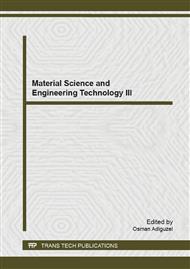[1]
L.Y. Wu. Status of advanced aerospace composite materials. CEATI. 117-132.
Google Scholar
[2]
C.R. Clinton, V.L. Rausch, J. Sitz, et al. 10th Int. Space. Plane. Technol. Conference. (2001).
Google Scholar
[3]
K. Sawada, M. Takashi. Conceptual design of two-stage reusable launch systems using X-33. 10th Int. Space. Plane. Technol. Conference. (2001).
DOI: 10.2514/6.2001-1790
Google Scholar
[4]
C.S. Gibson, J.C. Neidhoefer, S.M. Cooper, et al. Development and flight test of the X-43A-LS hypersonic configuraion UAV. 1st Unmanned Aero. Vehicl. Technol. (2002).
DOI: 10.2514/6.2002-3462
Google Scholar
[5]
K. Wang, X.H. Yu, Y.F. Xu. Research progress of epoxy adhesives with high-temperature resistance. Adhesion. 2013, 2: 63-65.
Google Scholar
[6]
X.B. Liu, X.J. Wang, X.M. Hui. Progress in epoxy resin of high-temperature resistance. FRP/CM. 2013, 3: 118-121.
Google Scholar
[7]
P.H. Liang, H. Su, S.H. Hu, H.J. Ji, Formulation design on high temperature resistant epoxy resin casting materials. Insulating mater. 2008, 41(2): 29-33.
Google Scholar
[8]
M. Zhang, C.Z. Wang, D.Z. Wu, Y.H. Yu, et al. Study on toughening of heat-resistant epoxy resin. Chin. Plast. Ind. 2004, 32(5): 11-13.
Google Scholar
[9]
X.Y. Hu, X.L. Yuan. Progress in high temperature resistant epoxy resin adhensives. Chem. Adhes. 2009, 31(9): 49-52.
Google Scholar
[10]
S. Sun, M.J. Liu, H. Wang, T.F. Cu. RTM molding process and its derive technology. Areos. Mater. Technol. 2010, (6): 21-23.
Google Scholar
[11]
F.J. Kong, Y.F. Y.Q. Liu. Research in composite RTM molding process parameters. Eng. Plast. Appl. 2009, 37(4): 42-44.
Google Scholar
[12]
G. Yan, X.B. Fan, X.M. Zhang, et al. Effects of RTM process parameters on the performance of composites. Develop. Appl. Mater. 2008, 23(2): 27-30.
Google Scholar
[13]
B.J. Zhu. Research on the heterogeneous repair of the injury of honeycomb-core T700/QY9611 composite sandwich structures. Changsha. 2013. 27-30.
Google Scholar
[14]
L.A. Mercado, M. Galia, J.A. Reina, Silicon-containing flame retardant epoxy resins: synthesis, characterization and properties. Polym. Degrad. Stab. 2006, 91: 2588-2594.
DOI: 10.1016/j.polymdegradstab.2006.05.007
Google Scholar
[15]
W.J. Wang, L.H. Perng, G.H. Hsiue. Characterization and properties of new silicone-containing epoxy resin. Polym. 2000, 41: 6113-6122.
DOI: 10.1016/s0032-3861(99)00790-9
Google Scholar
[16]
P.M. Hergenrother, C.M. Thompson, J.G. Smith. Flame retardant aircraft epoxy resins containing phosphorus. Polym. 2005, 46: 5012-5024.
DOI: 10.1016/j.polymer.2005.04.025
Google Scholar
[17]
R. Liu, X.D. Wang. Synthesis, characterization, thermal properties and flame retardancy of a novel nonflammable phosphazene-based epoxy resin. Polym. Degrad. Stab. 2009, 94: 617-624.
DOI: 10.1016/j.polymdegradstab.2009.01.008
Google Scholar
[18]
L. Li, J.L. Tian. Synthesize Hydantoin Epoxy and Peparation cured hydantoin epoxy/HHPA Mater. Eng. 2012, (3): 52-55.
Google Scholar
[19]
Z.F. Lan, B. Zhao, M.L. Wang. Rheological behavior of a hydantoin epoxy resin system. Develop. Appl. Mater. 2014, (1): 66-70.
Google Scholar
[20]
X.Q. Dai. Flow and infiltration performance of epoxy-curing agent reactive system in fiber preforms. Changsha. 2010. 78-86.
Google Scholar


